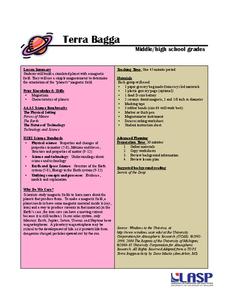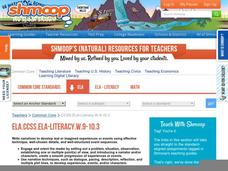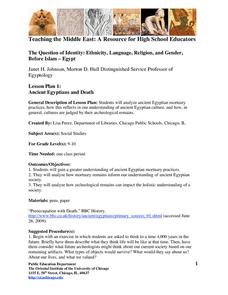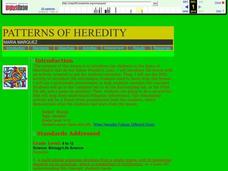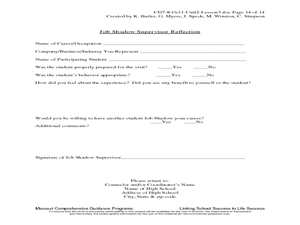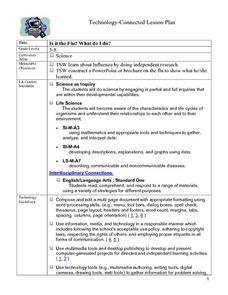Michigan City Area Schools
Goal Setting for Students
Inspire scholars to shoot for the moon with a presentation that details why goals are important, how to define and identify a goal with four essential questions, the difference between dreams and goals, and tips to achieving a goal.
University of Colorado
Terra Bagga
One way to identify possible volcanic activity on other planets is by testing the planet for magnetism. A science lesson begins with pupils constructing their own planet from a dead battery, magnets, paper, and tape before labeling...
Curated OER
Animals of the Arctic
Sixth graders research an Arctic animal. They survey the questions in the Animal Report in order to conduct their research. They investigate their chosen animal by using the Internet, library books and reference books.
Curated OER
Constructing Narrative from the Migrant Experience in Literature
Excerpts from John Steinbeck's The Grapes of Wrath and from John Fante's Ask the Dust, as well as a variety of primary source documents provide the background for an examination of the migrant experience from 1920-1945.
Rainforest Alliance
Knowing the Essential Elements of a Habitat
To gain insight into the many different types of habitats, individuals must first get to know their own. Here, scholars explore their school environment, draw a map, compare and contrast their surroundings to larger ones. They then...
Shmoop
ELA.CCSS.ELA-Literacy.W.9-10.3
Teach your class the basics of narrative writing! The resource first describes the Common Core standard for narrative writing in-depth, and then moves into how to apply the standard. Show your class the example essay and quiz them...
Cornell University
The Making of Macromolecules
Compare and contrast macromolecules made from the same elements. Young scholars learn how the structure of a molecule has as much influence on a compound as the elements in the molecule. They experiment with molecular model kits to...
Curated OER
Japanese Collage
Seventh graders compare and contrast different types of art associated with different cultures. They identify how cultures express their values in art. They create their own collage about Japan.
University of Chicago
Ancient Egyptians and Death
What archaeological evidence remains of ancient Egyptian burial and mortuary practices, and what can this information tell us about ancient Egyptian society?
Curated OER
Osmosis
Fifth graders explore osmosis as they watch organisms divide. In this organism lesson, 5th graders use potatoes to experiment with the effects of salty water in the body. Students discuss what osmosis is and record what...
Curated OER
Patterns of Heredity
Young scholars describe the differences between incomplete dominance and codominant alleles, and between multiple alleles and polygenic inheritance. They describe how internal and external environments affect gene expression. They then...
Curated OER
Analyzing and Evaluating Holocaust Literature
Learners examine the history of the Holocaust through literature. Using different pieces of literature, they critique the items in terms of being historical accurate and its value in telling the stories of the Holocaust. They create a...
Curated OER
High Performance in Agriculture Science: Graduates Outperform Others
Students plan for their future by exploring occupational experience programs.In this career lesson students list activities that they will participate in in the future and complete a career exploration project.
Curated OER
Saving An Endangered Species
Second graders participate in a fundraiser for an endangered species. They evaluate websites for animal adoption/sponsorship, select an endangered species, and develop, advertise, and implement a fund-raising plan for their selected...
Curated OER
A Demonstration of Photo-and Geotaxes in Nauplii of Artemia Salina
High schoolers explore phototaxis and geotaxis in brine shrimp. In this phototaxis and geotaxis lesson plan, students study the effects of light and gravity on brine shrimp using a test tube, a pen light and gravity. They answer...
Curated OER
The Band-Aid Counting Poem
Second graders listen to the teacher read a poem by Shel Silverstein and count the band-aids in the story.
Curated OER
Reasons for Seasons
Students investigate a model of the tilt of the Earth in its relationship to the Sun during the different seasons of the year. They study the solstices and equinoxes, while determining how sunlight hits the Earth with different angles in...
Curated OER
Navigating the World of Work
Twelfth graders complete job shadowing activities. In this career exploration lesson plan, 12th graders discuss their job interests and complete forms to participate in job shadowing activities. Students interview their job partner, ask...
Curated OER
Radial Design Mandala
Students design original radial art designs.In this radial design lesson, students use compasses and a nature inspired idea to create radial art. Students understand the use of symmetry, balance and design shapes in continual patterns....
Curated OER
Is It The Flu? What Do I Do?
Students use the internet to research the flu. Using various websites, they identify who should get flu shots, how to protect themselves and guidelines for getting over the flu. They write a one page report on their findings to end the...
Curated OER
How Do I Find Out More About...?
Eighth graders interpret historical evidence presented in primary and secondary resources. In this Era of Good Feelings instructional activity, 8th graders research historical figures of the Antebellum Period. Students use their findings...
Curated OER
Probability
Third graders conduct experiment, collect data, predict, record, and discuss outcomes, and analyze data for probability.
Curated OER
African Amercan Images in Harlem (1920-1950)
Eleventh graders compare and contrast different representations of African Americans in Harlem using visual sources. They detect point of views, themes, contradictions and ironies in sources using designed templates.
Curated OER
The Hijacker - How a Virus Spreads
Students view a video that presents how viruses attack the body and how the body's immune system responds. They simulate the spread of an infectious disease and establish the identity of the original carrier.

